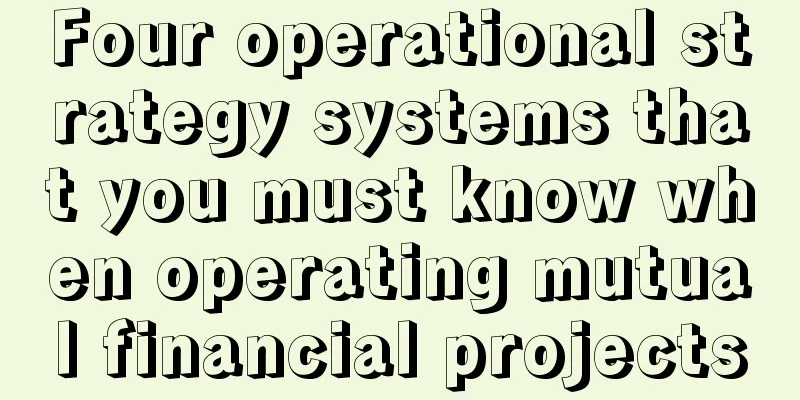In the previous article, we talked about using growth models to build estimates of business development paths, and combined with the operational strategy library, we can double the business growth in a short period of time. In this article, let's take a look at the composition of the strategy library for the operation of mutual finance business and what operational strategy systems are necessary to know. After all, only by knowing what cards are in the deck can you avoid missing out on better cards when playing. 01Strategy system with natural differentiation of operation types If you want to know what strategy systems are needed for the operation of mutual finance business, first look at all the operation strategy systems. In fact, each operation job represents an operation method and a strategy system. The formation of these jobs is itself the division of labor and separation formed by the spontaneous differentiation of operation work and strategy system after the high development. There are as many strategy systems as there are operation jobs. Our common operations jobs include user operation, product operation, event operation, algorithm operation, etc., which are universal to all industries. There are also operations jobs that only exist in this industry, such as commodity operation, merchant operation, member operation, content operation, new media operation, live broadcast operation, etc. Different types of operations represent different operation methods and strategy systems . For example, user operations mainly involve the stratification and reach of users; product operations involve the monitoring, optimization and innovation of products; activity operations involve the selection, design, promotion and review of rights and activities; and algorithm operations involve the use of automated and intelligent methods to manage users in a more sophisticated manner. The nature of the business determines what operational means and strategy systems are needed for business operations . For example, in the most classic and developed e-commerce industry, the essence of operation is to match people, goods and venues. People correspond to user operations, goods correspond to commodity operations, and venues correspond to product and activity operations. When the user base is large enough or the operation system is perfect enough, algorithm operations are also needed to improve the overall matching efficiency. The essence of mutual finance credit operation is the matching of assets and funds , or the matching of people and money. People correspond to user operations, and funds are usually connected by business colleagues. The matching of people and funds is mainly achieved by the credit system. Therefore, the operation of mutual finance is mainly based on the user operation strategy system, supplemented by general product operation and activity operation strategies. When the user scale is large enough or the operation system is perfect enough, algorithm operation will also be needed. Some installment e-commerce projects also have product operations, and most credit products also have member operations. These branch operation strategies will not be discussed. Today, we will mainly talk about the main operation strategy system of mutual finance: user operation, product operation, activity operation, and algorithm operation. 02The core of user operation is reach The core of the user operation strategy system is refined user reach . The four elements of refined reach are stratification, channels, content, and methods. Among the four elements, stratification and rights in content are the core. Here we mainly talk about stratification in user operation, and we put rights in activity operation. The stratification methods include life cycle stratification, user behavior journey stratification, user value stratification, and reach preference stratification . Life cycle stratification is to stratify users according to the life cycle methodology, namely, introduction, growth, maturity, silence, and loss. Behavioral journey stratification is to stratify based on the depth and breakpoints of users in the product process. User value stratification is based on the long-term value of users. There are four main dimensions in credit: demand intensity, borrowing ability, borrowing habits, and repayment ability. Based on these four dimensions, the user value can be comprehensively evaluated. For example, the RFM model is part of the borrowing habits. Reach preference stratification is based on the stratification of which channels, types of content, and types of rights and interests users like. Among these four stratification methods, stratification by life cycle is mainly used to divide all users, and the main application is the stratification of the silent period and the churn period. Segmentation by behavioral journey is mainly used for new user stratification, because new users are mainly active in the behavioral journey and have not yet formed value. Segmentation by user value is mainly used for old user stratification, because old users are already familiar with the behavioral journey, this part of the churn is less, and the value of old users has been formed, so they can be stratified in detail. The reach preference stratification is also for all users, and is mainly used when reaching users. For example, users with a higher preference for SMS reach should be reached by SMS first. The user operation strategy system is based on these four stratification methods to gain insight and analysis of users, and then form a corresponding reach system based on the user stratification and insight results. The strategy execution table in our next article will be designed and explained mainly based on the user operation strategy system. 03Product operation mainly involves monitoring, optimization, and new design Next, let's look at product operations. The strategic system of product operations has three main directions: product monitoring, product optimization, product function design and new products. Product monitoring is a routine operation, which mainly monitors the conversion rate of each product link. There is no need to pay attention to fluctuations within the normal range. When an abnormality occurs, it is necessary to analyze and find the cause. It is important to establish an automated monitoring and alarm mechanism to facilitate rapid response to problems. Product optimization is mainly aimed at the anomalies found in the previous monitoring, or the data valley found by comparing with the data of the same industry, and optimizing the reasons on the product side . For example, on the contract page that originally had no instructions, add an operation guide floating layer to guide users to complete the contract reading and increase the click rate of the contract page; for example, conduct AB on the credit granting process to find a more appropriate process sequence and improve the completion rate of submission. The launch of product functions is mainly divided into two aspects. On the one hand, there is the launch of operational functions , such as adding a top-level step-by-step activity promotion area and an exit retention pop-up window to the credit granting process to enhance the activity effect. On the other hand, there is the launch of functions that can enhance conversions , such as the launch of application information caching function, which can greatly reduce the operating cost of users entering the application process for the second time and enhance the user's application completion rate. 04Activity operations should be selected and operated between regular and large-scale activities The strategy system for event operations is divided into two directions: regular events and large-scale events. Among the content that users access, the rights and interests part usually relies on regular events, and regular events need to be designed based on the core needs of users . The needs of Internet finance users are usually lower rates, higher credit limits, and easier loan issuance, which correspond to interest-free coupons, repayment coupons, credit limit increase coupons, and cash coupons. In addition, based on the characteristics of the product, rights and interests coupons for related businesses can also be designed. For example, Meituan will have takeaway coupons, Qunar will have hotel coupons, and Yifuzhi will have phone bill coupons. Large-scale events are also very important. They are mainly periodic events with full user participation, high costs, and strong publicity . In the rising stage of the product, it can help quickly increase the number of users; in the mature stage of the product, it can wake up silent users and acquire a certain number of new users to prevent the product from entering the user shrinkage cycle. Due to limited space, I will not expand on this. Later, we will open a special article to talk about the design and operation of large-scale events. 05Algorithm operation includes three steps Algorithmic operation is actually a deepening and upgrading of user operation. The stratification that could be done manually can no longer meet the business scale, or the room for effect improvement is limited. Therefore, it is necessary to use intelligent decision-making methods and algorithmic operation strategies. Algorithmic operation includes three steps: user insight, data analysis, and model construction. User insight means that before building an algorithm model, you need to have a full understanding of the user's characteristics . For example, the value of an Internet finance user is mainly determined by four factors: demand intensity, borrowing ability, borrowing habits, and repayment ability. Demand intensity represents the probability that the user will spontaneously complete the process. The stronger the demand, the lower the marketing priority. Borrowing ability is determined by the user's credit limit and rate. The most important influencing factor is the remaining credit limit. The more credit limit, the higher the user's borrowing ability. Borrowing habits include the user's historical borrowing limit, average borrowing interval, and the most recent borrowing time. The more stable and good the user's borrowing habits, the lower the marketing priority. Repayment ability mainly examines the user's overdue situation. If the user has no repayment ability, there is no need to market to him. By analyzing the business and understanding the users, we can gain certain insights into the users. Then we need to analyze and verify these insights in combination with business data . For example, the intensity of demand can be observed using the time interval data from user registration to application submission, the entire application submission process, and application submission to loan submission. Then, we can combine these data with conversions to analyze the correlation between dimensions and conversions to see if they are consistent with the insight results. If they are consistent with the insight results, we can build a model. If they are not consistent with the insight results, we need to analyze the reasons for the disagreement to deepen our understanding of users and data. After the data and insights are consistent, you can start building the algorithm model. This step is mainly a technical work. As long as the final results of the model are verified by AB and are effective, and the model is simple and easy to use, and easy to trace anomalies, the entire model construction is considered a success. So far, the four major operational strategy systems that must be known for mutual finance project operators have been explained, which include user operation, product operation, activity operation, and algorithm operation. Among them, user operation is mainly based on 4 hierarchical methods to finely reach users, product operation is mainly product monitoring, product optimization and product functions, activity operation is the selection and design of regular activities and large-scale activities, and algorithm operation is to complete intelligent decision-making through insight, analysis, and model building. The above are the strategy systems that we must know when operating mutual finance projects. In the next article, we will explain the design method of the strategy execution table for the user operation strategy system. This article is authorized by the author to be published and operated by Pai. The copyright belongs to the author. |










